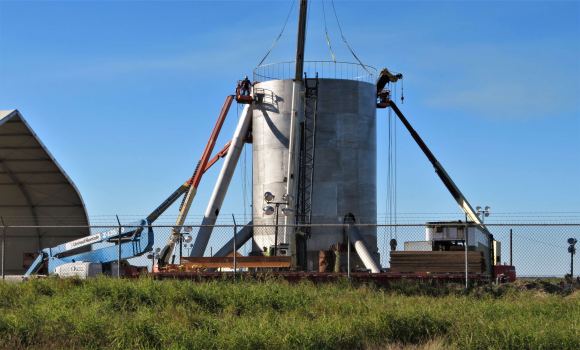Elon Musk has been a busy man in recent years. In September of 2016, he unveiled his company’s plan for a super-heavy launch vehicle – the Interplanetary Transport System (ITS). The following year, Musk presented the world with an updated design of the vehicle, which had been renamed the Big Falcon Rocket (BFR) and the Big Falcon Spacecraft (BFS). This past November, the launch system was renamed yet again to the Starship.
Musk also recently indicated that his company would be building a smaller version of the Starship to test the design. As the mission architecture has evolved, Musk has kept the public apprised of the progress of the ship’s construction. As usual, the latest update was provided via Twitter, where Musk shared images of the pieces of the mini-Starship ( aka. Starship Alpha) being rolled out in preparation for construction.
The images were taken at the company’s South Texas Launch Site and showed several completed sections of the prototype. These included the nose cone and pieces of the miniature Starship’s hull. Musk also took the opportunity to answer technical questions about Starship Alpha, which included the benefits of its stainless steel construction.
Stainless Steel Starship pic.twitter.com/rRoiEKKrYc
— Elon Musk (@elonmusk) December 24, 2018
This choice of material represents something of a shift for SpaceX, as the Starship’s design originally called for the use of carbon composites (CCs) in the hull’s construction. According to Musk, the stainless steel alloy that his company is using (300 Series Stainless) offers some unique benefits compared to CCs. This is due to the fact that the steel was “coldformed at cryo“, meaning that it was formed at cryogenic temperatures.
This process allows for an end product that is lighter and tougher than traditional hot-rolled steel. Addressing the question of stainless steel being heavier than CCs, Musk explained that while this alloy is heavier than carbon composites at room temperature, it is lighter and stronger at cryogenic temperatures – ranging from –150 °C (-238 °F) to absolute zero (-273 °C; -460 °F).
The same holds true for high temperatures, since stainless steel’s natural reflectivity makes it highly-resistant to heat – therefore requiring less in the way of heat shielding. Better performance under extreme temperatures is essential when it comes to space flight, where spacecraft experience both extreme cold in space and extreme heat during reentry.

Musk also addressed questions about the “radically redesigned” Raptor engines that will be used for the Alpha’s test flight next year. When asked if the company was still on track for its scheduled test firings at the SpaceX Rocket Development Facility in McGregor, Texas, Musk tweeted that the redesigned engine would be “ready to fire next month.”
He also included some specs on the redesigned engine, which included that it would be a “full flow, gas-gas, staged combustion” engine capable of reaching “up to 300 bar.” The engine would also be fueled by turbopumps capable of generating 100,000 horsepower each. Based on these specs, it is likely that the prototype Starship will weigh the same as a Falcon 9 Block 5 rocket (549,054kg; 1,207,920 lb) and will be able to generate comparable thrust.
The hop test of Starship Alpha will be taking place at the SpaceX South Texas Launch Site and is scheduled for June 2019, though the company may be ready as soon as March. Musk also confirmed that this test will involve Starship Alpha delivering some of SpaceX’s Starlink broadband internet satellites to orbit. “Starlink V1 on Falcon, V2+ on Starship,” he tweeted. “Basically, all future products will contain either the word “star” or “link”.
Further Reading: Teslarati


The nosecone seems to have a big ding in it at the bottom edge facing us. He’s building it in a field. This doesn’t look NASA at all.
You can make something shiny and perfect in a clean room as NASA does, but this becomes harder as your ship becomes bigger and more complex. In then end, you have to make it capable of surviving a few imperfections. Carbon fiber is strong up to the yield point, but once it yields the fibers snap and the matrix cracks and it is permanently weakened. Steel can yield a bit and still remain strong.
I think Musk is doing the right thing. But it does look weird to be bashing together a spaceship in a field.